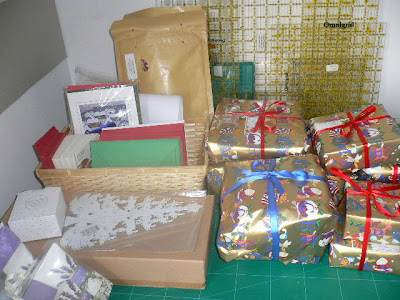The Fabric Covered Box
(The Art of French Cartonnage)
Materials needed:
Grey card board 2.5 mm thick (1/10 inch)
Book Cloth (sometimes called Book Linen)*
Decorative paper for lining the box
Cutting Knives and/or Rotary Cutter
Cloth pegs or small clamps
*Can be found in good craft/paper or bookbinding shops.
First decide on the size of your box: width, depth, height. Then measure and draw out the lines on cardboard.
2 pieces for the lid and base (width by depth)
2 pieces for front and back (width by height)
2 pieces for sides (height by depth (depth minus 0.5 cm)
Cut the cardboard pieces . Note that I use the rotary cutter instead of the cutting knive as I find it easier. Take care to cut precisely.
When all the pieces are cut, they should look something like this.
Now glue your box with PVA (or any clear drying glue). First the front and back onto the base
then the sides in between.
Cut a piece of batting the size of the lid and lightly glue in place (optional).
Lay your piece of fabric, face down, on the table. By moving the box step-wise over the fabric, mark out with a pencil the outline of the box. Make sure to leave a 4 mm space in between the back of the box and the lid.
Now add a "tab" of about 2.5 cm around the whole outline of the box and then cut out on that line.
Now your piece of fabric should look something like this.
Cover the base of the box with a thin but even layer of glue and wait a short while until the glue doesn't feel wet but slightly sticky.
Now stick it precisely onto the outline of the base on your fabric.
Cut 45 degree darts into all for corners.
Then apply glue to the front and back and stick fabric to the box.
Now tip the box so it is standing on its front wall and cut and remove a rectangles at both corners. Then make additional cuts as shown.
Then glue these two small tabs onto the edge of the side walls
and the large tab into the box.
Now stand your box on its back wall and cut a dart parallel to the edge of the back wall on both sides.
Then glue these side tabs to both sides of the box.
Now fold in and "finger press" the extra fabric tabs, making sure they are straight, then glue in place. Do the same for the other side of the box.
Apply glue to both side walls, the edge and a bit along the inside of the box and then stick the fabric on and into the box.
With the box still standing on its back wall align the lid now with the box, making sure you leave a small gap for the hinge.
Then apply glue to the sides, fold the tabs over the edge as shown and stick down.
The front edge is then trimmed by cutting a triangle as shown then folded in, then glued lightly. Now fold over and glue this tab to the inside of the lid.
Cut a hinge from bookbinder's linen; lenth of spine by 4 cm. Draw a line 1.5 cm from long side and trim about 1.5 mm (the thickens of the card board) on each side so that the cloth fits perfectly inside the box.
Glue out the hinge and stick it down. Immediately force the cloth into the joint with a bone folder. Rub vigorously until the cloth is well adhered to all surfaces.
Now let the box sit open for a few minutes to let the hinge dry.
Measure the inside of the base adding 0.5 cm all around. Then measure the front and back (height minus 0.5 cm, width plus 0.5 cm on both sides. The sides are measured minus 0.5 cm for the height.
Now draw the cutting lines on the wrong side of the lining paper and cut out.
You will need these five pieces of paper.
Score lines 5 mm from the edge all around then cut and remove the small squares in the corners.
Now fold the sides up.
Apply glue to the bottom of the box and carefully stick the paper in, making sure you don't get any blisters.
Then score and fold the front an back papers at the narrow ends and glue into place. Note how the papers cover all the corners.
Lastly glue the side papers in.
In order to be able to close the box, we need to attach an inner lid to the box lid. First measure the inside of the box and cut a piece of card board very slightly smaller (about 1 to 2 mm). Cover this inner lid with either the lining paper or as shown here with the fabric.
Find the middle of the box lid, mark it and fix a tassle or ribbon with the help of a piece of double sided tape.
Apply glue to the inner lid and carefully glue the inner lid onto the box lid, making sure that it is placed so that the box can be shut.
Clamp in place until the glue is dry.
If you like, you can now make partitions for your box. Cover some cardboard strips (height of box minus 1 cm) and cut into partitions, making sure they fit exactly wall to wall.
First glue in the longer partitions, then measure and cut the small ones in between.
The inside of the finished Tea Box!
Admire and enjoy your Box!
If you need help with this or need clarification on anything, please don't hesitate to contact me. See email address on side bar.
Have a great weekend.
Vreni






























.JPG)
.JPG)

.JPG)

.JPG)






.JPG)


.JPG)
























